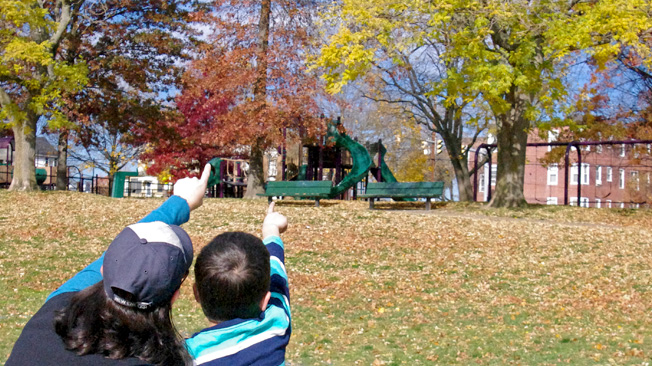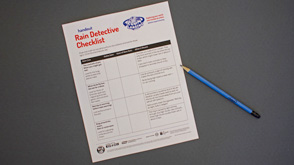Rain Detective

What Is This Activity?
Is rain on the way? Can you tell before the storm clouds roll in? You and your child look up to the sky for clues that the weather is about to change.
Introduction

Big Science Ideas
- Before a rainstorm, the wind, temperature, and air pressure change, and those changes affect animals, plants, and the sky.
Go Outside 45 minutes

- Step outside and ask your child: Do you think it will rain later today? How can you tell?
- Take a deep breath together. What do you smell? Are the odors strong or weak? Explain that right before it rains, odors in the air are stronger. Your child can learn the "rain smell" by taking a deep breath outside each day and noticing differences. How does the air smell after rain?
- If possible, climb to an enclosed rooftop on a building (for some exercise, take the stairs!) or up a hill with a view of the sky. Ask: How's the air up here? Fresher? Cooler? Windier? Explain that the air, the temperature, and the wind speed and direction all change as you go higher. The changes happen from the ground all the way to the edge of space! Air gets thinner (there's less of it), for example, and pollutants like smog hang close to the ground. Has your child flown in an airplane? The changes in air pressure can cause ears to hurt or "pop."
- Read the first row of the "Rain Detective Checklist" about jet contrails (long white clouds that a plane makes, high in the sky). If you see one, ask: How many contrails can you spot? Will it rain in three days? Wait and see! Record today's date and the date of the next rain on the chart.
- If there are no contrails today, discuss why. (The atmosphere is very dry. No planes are flying overhead.) Encourage your child to keep looking for contrails on clear days and track the dates they are seen on the chart. In general, the more time contrails last in the sky, the more moisture there is; longer than 20 to 30 minutes is very moist.
- Look for flying birds, the next row on the chart. Ask: Are the birds flying low or high? If you're not sure, watch them fly over a couple of days to notice changes. Here are a few tips:
- Flocks of birds, like swallows, are easy to spot.
- Migrating birds feel drops in air pressure strongly. Their shift from flying high to flying low is clear.
- Hawks, falcons, and other birds of prey normally fly very high, so it's easy to notice when one is flying low.
- Look together for the last two "Rain Clues" at sunrise and on an evening when you can see the moon.
- Read the Rain Clues together to see what weather words come up over and over (wet, dry, air pressure). Rain is likely when the atmosphere is wet—when it contains a lot of water vapor, droplets, or ice crystals. Also, rain is likely when the air pressure changes from high to low. Air pressure means how hard air is pressing down on the ground.
Explore Some More
Smoke and Rain
Are there factories or power plants with smokestacks in your city or town? Or rising steam from subway vents? If so, you have another Rain Clue to add to your chart! If the smoke or steam rises straight up, weather is good and likely to stay that way. But if it starts to twist around and drop low, that means rain is likely. (It's a sign that air pressure is dropping.)
Where Does All the Snow Go
When the temperature is below freezing, water can drop from clouds as snow instead of rain. Watch and listen as Plum sings a song about what happens to snow that piles up in a city or town.
Outdoor Family Fun with Plum App
This app gets families outdoors exploring the world. Every day, the app offers five outdoor missions to get everyone thinking and talking about nature and the science that's all around us.

